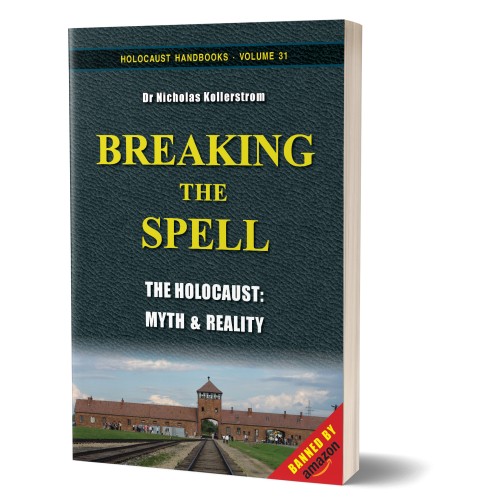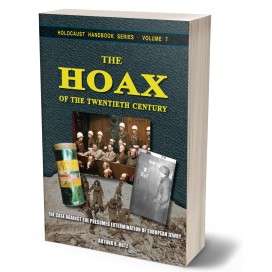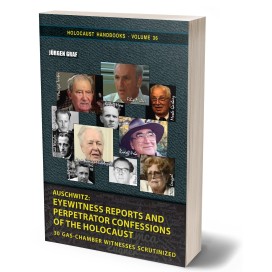Nicholas Kollerstrom: Breaking the Spell – The Holocaust, Myth & Reality
6th slightly updated edition, Bargoed: Castle Hill Publishers, 2023
Language: English
Beschreibung
Were the British here hoodwinked by the Nazis, as some historians to this day try to claim—or is the truth both simpler and more shocking?
In 1988 and 1991, forensic studies threw light on the question of whether or not the claimed gas chambers at Auschwitz had served as slaughter houses for hundreds of thousands of people. Both studies had concluded that the only facilities where Zyklon B gas had been used were hygienic rather than homicidal, killing bugs rather than Jews. Needless to say that these iconoclastic studies were ignored or in some countries even outlawed, and that their authors were ostracized and even imprisoned.
Dr. Kollerstrom, a science historian, has taken these studies, which are in obvious, stark contrast to the widely accepted narrative, as a starting point for his own endeavour into the land of taboo. After he had published a brief paper summarizing what he thought the data forced him to conclude, he was thrown out of his College where he had been a member of staff for eleven years.
In his new book Breaking the Spell, Dr. Kollerstrom shows that “witness statements” supporting the human gas chamber narrative clearly clash with the available scientific data. He juxtaposes the commonly accepted ideas about a Nazi extermination policy toward the Jews with a wide array of mostly unchallenged, but usually unmentioned evidence pointing in a quite different direction:
- Zyklon B is a buzz word for the claimed Nazi mass murder, but all non-anecdotal evidence proves that this chemical was merely used as a pesticide in order to improve the inmates’ health and reduce, not increase, camp mortality.
- The Auschwitz camp authorities kept meticulous records of who died in the camp and why. A statistical analysis of the data does not match the kind of data to be expected, if the widespread view of what transpired in that camp were true.
- The UK’s intelligence decrypts prove that the German camp authorities were desperately trying to save their inmates’ lives.
- Zyklon B applied in delousing chambers formed chemical compounds detectable to this day. No such compounds can be found, but ought to be expected, in the claimed homicidal gas chambers.
- “Six Million Jews threatened or killed”: read 167 quotes from newspapers with that “news” spanning from 1900 to 1945, with a peak after World War ONE! Yes, one, not two!
- Germany has paid compensation to millions of Nazi victims, and Israel has implicitly admitted that many million Jews survived the Holocaust.
- A British archaeological team looked for traces of the claimed 800,000 victims of the Treblinka camp—and came back empty-handed.
- The Auschwitz camp had for the inmates: a swimming pool, soccer games, theatre, library, choirs, orchestras, hospital with modern surgeries…
Dr. Kollerstrom concludes that the history of the Nazi “Holocaust” has been written by the victors with ulterior motives and that this history is distorted, exaggerated and largely wrong. He asserts that this history is, in truth, a great lie that distorts our common perceived reality and misdirects human history to this very day.
With a foreword by Prof. em. Dr. James H. Fetzer; contains a bibliography and an index.
286 pages, paperback, illustrated, bibl., index (Holocaust Handbooks, Volume 31)
Kommentare
Der Schelm läßt übrigens die schwachmatischen "Kommentare" neurotisierter Antifanten zu seinen Büchern bewußt stehen, um klarzumachen, wes Geistes Kind diese bedauernswerten Kretins sind. Der Schelm ist allerdings Humanist und Optimist und daher voll davon überzeugt, daß sich der mentale Zustand der Linksdrifter mit der Zeit verbessern wird.
Ähnliche Produkte
Butz, Arthur R.: The Hoax of the Twentieth Century – The Case Against the Presumed Extermination of European Jewry
Jürgen Graf: Auschwitz: Eyewitness Reports and Perpetrator Confessions of the Holocaust – 30 Gas-Chamber Witnesses Scrutinized





